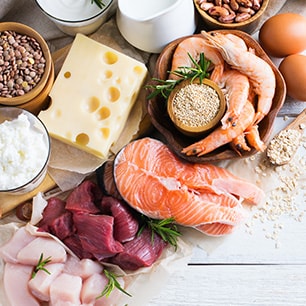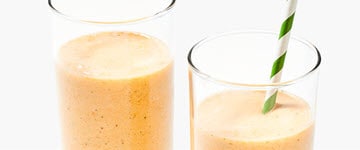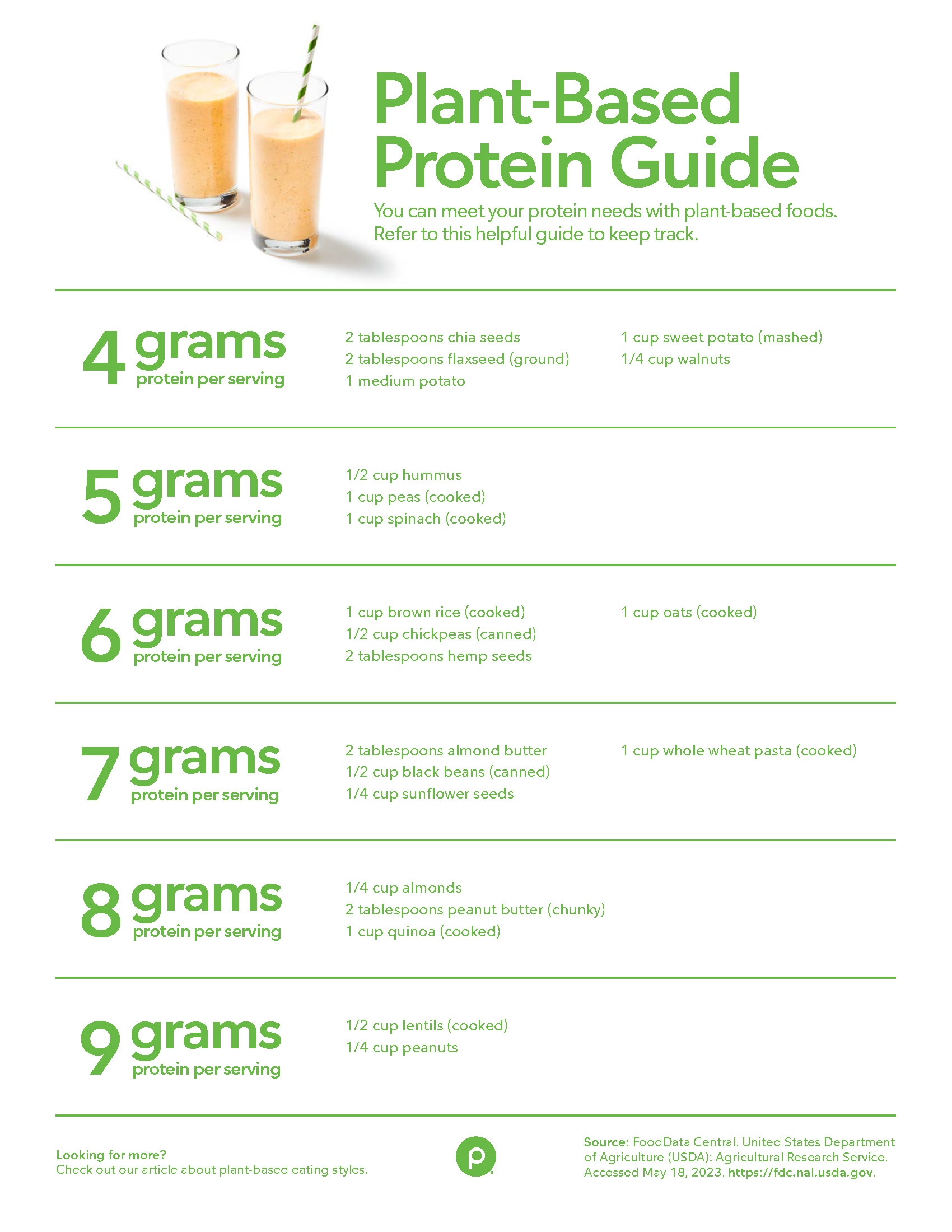Updated June 16, 2023
Protein is a fundamental part of your food routine on your path to wellness. Proteins function as building blocks for everything from bones, muscles, and skin to enzymes, hormones, and vitamins.1 Learn more about the power of protein and how to integrate quality proteins from a variety of sources into your diet.
Recipes.
How much protein should I have daily?
The Dietary Reference Intake, or DRI, for protein is 0.8 grams of protein per kilogram of body weight, or 0.36 grams per pound of body weight. This amounts to about 56 grams of protein per day for the average man, and about 46 grams of protein a day for the average woman.2 Certain groups, including active and older adults, may benefit from higher protein intakes.

Can protein help me lose weight?
Increasing your protein intake may help with weight loss if it doesn’t mean eating excess calories. Research suggests that at least 25–30 grams of protein per meal may help increase your feeling of fullness or satiety.3 Since you need a calorie deficit to lose weight, typically you must cut back on calories. Adding more protein to your diet can help you feel satisfied and less hungry even within your calorie constraints.3
Can protein help curb my appetite?
Protein increases the feeling of fullness you get after you finish a meal. Include sources of protein at meals and snacks to help you stay satisfied.4
Can protein help me gain muscle?
Protein can promote muscle mass. The daily recommended amount of protein is 1.2–1.7 grams of protein per kilogram of body weight or 0.5–0.8 grams per pound of body weight. For example, a 150-pound individual needs 75–120 grams of protein per day. But even if you are not a bodybuilder or avid gym enthusiast, it’s still important to get enough protein in your diet to prevent the loss of lean muscle mass that occurs as we age. Older adults may benefit from a daily protein intake between 1.2–2.0 grams per kilogram or 0.5–1 grams per pound of body weight.5
Consult your physician or registered dietitian for the amount of protein that fits your personalized needs.
Switch up your proteins.
When it comes to protein, quality and variety are important too. Focus on choosing diverse protein sources that include nutrient-dense and plant-based options. Add a variety of protein foods into your routine, incorporating seafood, lean meats and poultry, eggs, legumes (beans and peas), nuts and seeds, and soy products.6
Pick the best protein options.
Here are some pointers to help you make wise protein choices.
- Beef: Look for cuts with “round” or “loin” in the name—top round steak, top loin steak, or tenderloin. Choose ground beef with a higher lean-to-fat ratio, such as 90/10 or 93/7.
- Pork: Again, find round or loin cuts, such as pork loin, tenderloin, and center loin.
- Poultry: Start with skinless white meat chicken or try skinless dark meat cuts.
- Seafood: Eat seafood at least twice a week. Great choices include omega-3 sources such as salmon, trout, oysters, crab, mussels, catfish, clams, and flounder.7
- Eggs: Add eggs to your weekly routine beyond breakfast in frittatas, sandwiches, fried rice, and more.
- Dairy: Include fat-free or low-fat milk and yogurt—as well as less-fat or reduced-fat cheeses—in your repertoire.
- Protein powders: Try our GreenWise whey protein in smoothies like our Publix Aprons Peach-Mango Protein Smoothies. Make it plant-based with yogurt made from coconut milk and plant-based GreenWise protein powder.
- Plant-based: Try the variety of choices we offer, whether you’re a vegan, vegetarian, or trying to eat more plant-based foods. Combining different protein sources in the same meal isn’t necessary.8
Try these tips for building a variety of plant-based proteins into your meal plan.
- Nuts and seeds: Enjoy unsalted or lightly salted nuts or seeds as a snack, on salads, or in main dishes. Eat small portions to keep calories in check. Check out our Publix snacks, such as sunflower seeds and cashews, located in our Produce department.
- Beans: Choose reduced-sodium or no-salt-added canned beans, such as GreenWise low-sodium canned beans, or simply drain and rinse canned beans to reduce the sodium. Or prepare Publix or GreenWise dry beans in your favorite recipe. Try our Hearty Potato and Lentil Salad with lentils, asparagus, and arugula.
- Meat alternatives: Try our variety of meatless protein options, such as tofu and tempeh, in our Produce department, as well as meatless burgers and entrées in our frozen section.
- Better choices: Look for our Better Choice shelf tags that can help you make small shifts in your food choices within certain categories of products. When compared to similar products, the tags identify items that have more of the nutrients you need, like fiber, and less of the things you don't need, like saturated fat, added sodium, or added sugar.
Looking for more? Check out our articles about plant-based eating styles.
For the love of you.
Choosing how you eat is uniquely personal. It’s about your needs, your preferences, and your goals. As your wellness ally, Publix is in your corner with fresh ideas, recipes, and wellness icons that make it easier to shift toward wiser food choices. It’s all about you, at your very best.
Sources
1Dietary Proteins. National Library of Medicine. March 25, 2015.
2Dietary Reference Intakes. National Academies Press. Accessed April 20, 2023.
3Leidy, Heather J., Peter M. Clifton, and Arne Astrup et al. The Role of Protein in Weight Loss and Maintenance. The American Journal of Clinical Nutrition. April 29, 2015.
4Paddon-Jones, Douglas, et al. Protein, Weight Management, and Satiety. The American Journal of Clinical Nutrition. May 1, 2008.
5Baum, Jamie I., Il-Young Kim, and Robert R. Wolfe. Protein Consumption and the Elderly: What Is the Optimal Level of Intake? National Library of Medicine. June 8, 2016.
6U.S. Department of Agriculture. What Foods Are in the Protein Foods Group? MyPlate. Accessed April 20, 2023.
7Which Fish Is the Richest in Omega-3s? Seafood Nutrition Partnership. Accessed April 20, 2023.
8Palmer, Sharon. Protein in Vegetarian and Vegan Diets. Eat Right. Accessed April 20, 2023.

 You are about to leave publix.com and enter the Instacart site that they operate and control. Publix’s delivery and curbside pickup item prices are higher than item prices in physical store locations. Prices are based on data collected in store and are subject to delays and errors. Fees, tips & taxes may apply. Subject to terms & availability. Publix Liquors orders cannot be combined with grocery delivery. Drink Responsibly. Be 21. For prescription delivery, log in to your pharmacy account by using the Publix Pharmacy app or visiting
You are about to leave publix.com and enter the Instacart site that they operate and control. Publix’s delivery and curbside pickup item prices are higher than item prices in physical store locations. Prices are based on data collected in store and are subject to delays and errors. Fees, tips & taxes may apply. Subject to terms & availability. Publix Liquors orders cannot be combined with grocery delivery. Drink Responsibly. Be 21. For prescription delivery, log in to your pharmacy account by using the Publix Pharmacy app or visiting 

